Hindu Dharma has taught us how to perform various achars associated with cooking in an appropriate manner. Let us understand through this article, the importance of Bharatiya cow and ghee prepared from the butter obtained by churning old curd made from cream of milk. Also let us find out harmful effects of consuming processed butter and cheese.
1. Why is cow considered holy in Hindu Dharma?
Hindu Dharma considers cow to be a very Holy animal because ghee made from cow’s milk is very sattvik (Sattva-predominant).
A. Importance of cow’s milk and its function
Cow’s milk acts as a medium for attracting the sagun (Materialised) source of Deities from the universe. The manifest functional energy of Deities can act through the medium of milk.
B. When milk gets converted into curd,
its Raja component increases
When milk gets converted into curd, the Raja component in it increases. As a result, its function on the basis of kriya-shakti (Energy of action) in the form of sanskars increases.
C. Raja component in curd
Milk is considered as creation of sagun, while curd are considered to be an active component that takes creation towards production on the strength of the Raja component.
D. When curd gets converted into buttermilk
Tej-tattva (Absolute Fire Principle) congregates in it
When curd gets converted into buttermilk, fluidity of the Raja component increases due to which a small percentage of Tej congregates in it. Therefore, buttermilk is considered to be the functional flow of production.
E. Churning curd in a particular manner generates Tej-tattva
By churning curd in a particular manner, energy is generated in it at the level of Tej tattva, which leads to congregation of the Raja component at the level of Tej. This energy makes the curd fluid and separates itself from buttermilk in the form of butter. Thus, on the basis of Tej, butter gets separated from buttermilk.
G. Subtle-characteristics of cow’s milk
1. Cow’s milk is sattvik and rich in Chaitanya
God Himself has created the cow for the welfare of mankind. Hindus even worship the cow as a Deity. Cow is a sattvik creature and hence, her milk is sattvik and rich in Chaitanya.
2. Drinking cow’s milk leads to purification at the physical and spiritual level
Those who drink cow’s milk become sattvik in nature. They also experience relief from stress and experience calmness. The vibrations of Shakti in milk destroy the Raja-Tama components in the body, mind and intellect of individuals who drink it, thus purifying them at the physical and spiritual level.
3. Unboiled milk
Raja-Tama vibrations from the environment get attracted to the cow’s milk and hence, there is some amount of Raja-Tama in the milk that is not boiled.
4. Boiled milk
Tejtattva activated during the boiling of milk destroys the Raja-Tama in it.
5. A seeker boiling milk
If milk is boiled by a seeker, more sattvikta (Purity) is generated in it.
2. Characteristics of ghee made
from the milk of different types of cows
|
Ghee made from The |
Ghee made from the milk of a buffalo |
Ghee made from the milk of Bharatiya breed cow |
|
|---|---|---|---|
| 1. Energy |
|
||
| A. Destroyer energy | – | 2 | – |
| B. Saviour energy | – | – | 1.5 |
| 2. Chaitanya | 1 | 2 | 3 |
| 3. Anand (Bliss) | – | – | 2 |
| 4. Deity Principle | – | – | 2.8 |
| 5. Negative energy | |||
| A. Distressing energy | 1.8 | – | – |
| B. Illusory energy | 2 | – | – |
| 6. Reasons for the ghee to be sattvik or non-sattvik | |||
| A. Effect of the environment | This cow is of a foreign breed (meaning, place high in Raja-Tama component) and hence, is less sattvik | Bharat is sattvik, hence, the sattvikta is attracted to the buffalo. | People in Bharat perform puja (Ritualistic worship) and religious rituals regularly and hence, the environment here is sattvik and this is the reason why cows in Bharat are sattvik |
| B. Vibrations in the cow / buffalo | Distressing energy | Existence of destroyer character & female-energy as well as character of fighting for self-protection and Chaitanya | Due to the presence of 33 types of Deities, it is most sattvik and has the ability to attract positive energy |
| C. The attitude with which people see a cow or a buffalo | No respect; since it is not worshiped, it is killed for beef. | When compared with a cow of local breed, the buffalo is less respected. | People in Bharat still worship the cow & hence, the Deity Principle gets attracted to it as well as the ghee prepared from its milk. |
| 7. Characteristics | |||
| A. Taste | Not delicious | A bit strong | Sweet |
| B. Vibrations and effect | We get attracted to this ghee because of the distressing energy and illusory energy, and the ghee tastes sweet and appears to be better than the ghee of a local Bharatiya breed cow | Due to the presence of energy, it appears to be good and hard | Pure, sattvik and presence of Chaitanya |
A. Since the basic nature of different cows varies, the vibrations in the ghee prepared from their milk also vary.
B. Ghee made from the milk of a Bharatiya breed cow is most sattvik. Its consumption does not harm the body.
3. Subtle-characteristics of sattvik
ghee prepared from the butter obtained
by churning old curd made from cream of milk
A. Ghee prepared from the butter obtained by churning of old curd is sattvik and hence, it is used in puja and religious rituals.
B. The seva of melting butter by heating if performed with bhav (Spiritual emotion), this ghee attracts nirgun Chaitanya.
C. Ghee is good for health. It purifies an individual at the materialistic as well as spiritual levels. It is also useful as medicine for various ailments at both these levels.
D. Intake of ghee destroys distressing energy in certain parts of the body.
E. Lighting a ghee lamp destroys the distressing energies, especially during religious rituals.
F. It is because of the purity of ghee, that its consumption gives the spiritual experience of Shanti (Peace).
4. Proportion of trigun in milk, curd,
buttermilk, homemade butter and ghee
| Proportion (%) | |||
|---|---|---|---|
| Sattva | Raja | Tama | |
| 1. Milk | 50 | 30 | 20 |
| 2. Curd | 30 | 50 | 20 |
| 3. Buttermilk | 10 | 70 | 20 |
| 4. Butter | 30 | 50 | 20 |
| 5. Ghee | 70 | 20 | 10 |
Though from the trigun point of view, curd and homemade butter appear similar, their intrinsic properties of functioning at the level of Panchatattvas are different. Curd function at the level of Creation, while butter leads from Creation to Dissolution.
5. Why items made from
processed milk should not be eaten?
Milk is considered to be the source of sagun-Chaitanya and hence, is a complete food. That ingredient which functions through the medium of Sattva component for the welfare of others is called sattvik. Since milk is sattvik, intentionally turning the milk sour amounts to accumulation of the Raja-Tama-predominant foreign ingredients and destruction of the ingredient that functions through the medium of sattvikta. Such food items without the Sattva component prepared by turning the milk sour are harmful for the body. Eating these congregates distressing vibrations in the body, and it becomes an invitation to many diseases. Therefore, items that are harmful to life should be avoided; else, one has to face distress due to negative energies working subtly through the medium of these contaminated waves on a large scale.
6. Subtle-characteristics of processed butter
A. Processed butter available in market is made in a manner that people enjoy its taste. Therefore, illusory vibrations are generated in it and as a result, people not only get attracted towards the processed butter but also develop a liking for it.
B. Such butter lacks in sattvikta and hence, Divine Shakti and Chaitanya do not get attracted to it.
C. Proportion of positive or negative vibrations in the processed butter depends on the milk used in its preparation, proportion of chemicals and the country in which it is manufactured.
7. Subtle-characteristics of
various types of cheese in the market
There is just one method of preparing cheese; however, processes of solidification and preservation are different. All these processes and their subtle-effect on cheese are given ahead. All numbers in the table given ahead denote percentages.
|
Smoked cheese |
Processed cheese |
Elemental cheese |
Fresh cheese |
|
|---|---|---|---|---|
| 1. Method of preparation and preservation | To make it dry and long-lasting, it is smoked with cool smoke and then baked | To improve the taste, taste-enhancing chemical ingredients are added |
To harden the prepared cheese, it is kept in a specific instrument or under the soil in a pit for a few months |
This is homemade and has no ingredients added for taste |
| 2. Shakti | – | 2 | 3 | |
| 3. Negative energy | ||||
| A. Distressing energy | 3 | 1.5 | 1 | |
| B. Energy of attraction | 2 | – | – | |
| 4. Reason for being non-sattvik
|
Mechanised cooling and heating and hence, presence of distressing vibrations | Is a chemical substance and hence, there is presence of distressing energy and energy of attraction | It is not a chemical substance and hence, presence of Shakti |
It is not a chemical substance and hence, presence of Shakti |
| Has distressing energy | The energy of attraction in this type attracts the distressing energy from the environment | Since it is kept underground, distressing energy from Hell gets attracted to it |
Distressing energy from Hell gets attracted to it |
A. Cheese is made from the milk of goat or jersey cow. Distressing energy is present to a greater extent in cheese made from goat’s milk than that made from jersey cow’s milk.
B. In Bharat, consumption of processed cheese is more.
C. Fresh cheese perishes in 3 to 7 days; hence, it has to be consumed quickly.
8. Subtle-effects of processed butter, ghee
made by common man and ghee made by seekers
In many western countries, processed butter is used more. Use of processed butter in Bharat is also on rise. Some dishes are prepared by using processed butter instead of oil or ghee. Many people use processed butter while cooking vegetables to add taste. Chemically processed butter lacks in nutrients and sattvikta. On the other hand, no chemicals are used while making ghee, and hence, it has sattvikta and is also good for health. Therefore, it is beneficial to use ghee instead of processed butter in food preparations. It would be best to chant while making ghee and remaining in communion with God. This will impart Chaitanya to the ghee. Seekers perform all actions in this manner; whereas, common man does not have this habit. Hence, the ghee prepared by seekers has Chaitanya and is most sattvik. Given ahead is a table showing the subtle-effects on an individual upon consuming processed butter, ghee prepared by common man and ghee prepared by seekers. All numbers in the table given ahead denote percentages.
|
Processed butter |
Ghee prepared by a common man |
Ghee prepared by a seeker |
|
|---|---|---|---|
| 1.Method of preparation | Mechanised, addition of chemicals as preservatives, so also addition of fatty products | Homemade butter is melted using fire and thus ghee is prepared | |
| 2. Shakti | 0.5 | 1.5 | – |
| 3. Bhav | – | – | 2.5 |
| 4. Chaitanya | |||
| A. Nirgun | – | – | 2.8 |
| B. Sagun | – | 3 | – |
| 5. Anand | – | 2 | 3 |
| 6. Principle of Agnidevata | – | 2.8 | 2 |
| 7. Negative energy |
|
||
| A. Distressing energy | 2.5 | – | – |
| B. Illusory energy | 2 | – | – |
| 8. Reasons for being sattvik or non-sattvik | Mostly prepared in Raja-Tama-predominant western countries, and since the method of preparation is incorrect (chemical process), there is presence of distressing energy in it | Due to the sattvikta in Bharat, positive vibrations are attracted to it and it has saguṇ–Chaitanya | Seekers prepare ghee with a bhav that it is part of their spiritual practice and hence, saguṇ–Chaitanya and Anand get attracted to it |
| 9. Effect on the individual | Difficult to digest, causes ailments of the body, possibility of suffering from high blood pressure because of increase in weight | Elimination of the distressing energies and feeling better | Being subjected to spiritual healing because of the positive vibrations, so also feeling good |
A. In Bharat, a ghee lamp is lit during puja and religious ceremonies. A ghee lamp emits positive vibrations.
B. Ghee is used in some Ayurveda treatments as well.

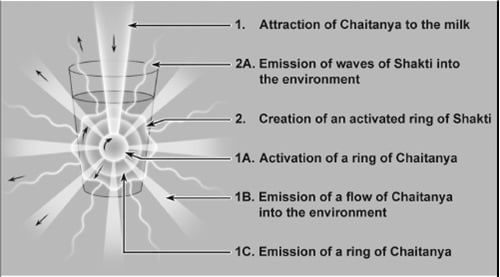
 Realise the power of water and make full use of it
Realise the power of water and make full use of it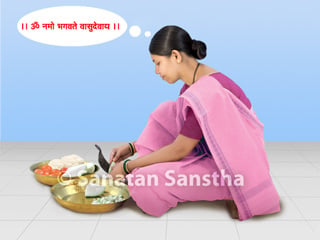 Importance of love for others and spiritual emotion for God while cooking
Importance of love for others and spiritual emotion for God while cooking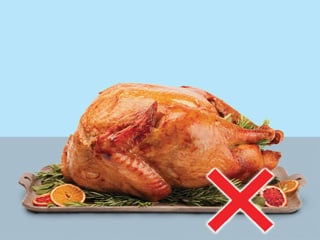 Effect of cooking non-vegetarian food
Effect of cooking non-vegetarian food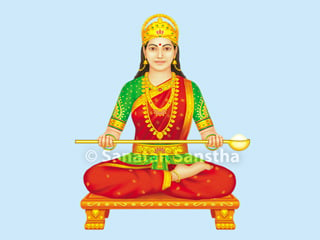 Shri Annapurnadevi
Shri Annapurnadevi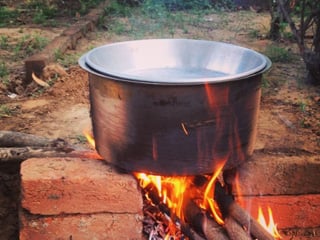 Conducts related to cooking and preparation of food
Conducts related to cooking and preparation of food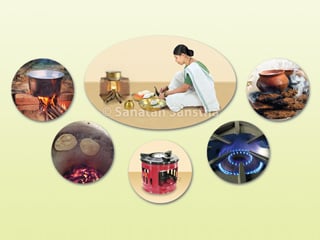 Methods of cooking, appliances, their benefits and harm
Methods of cooking, appliances, their benefits and harm